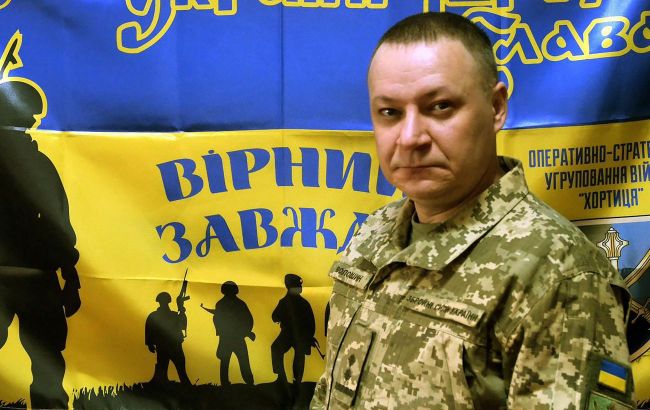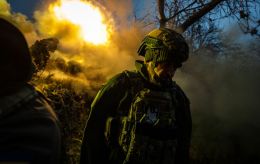Nazar Voloshyn, Ukraine's Khortytsia military unit: Russia is advancing in Kharkiv region to pull our forces out of the East
 Nazar Voloshyn, spokesperson for the Khortytsia military unit (photo: Facebook)
Nazar Voloshyn, spokesperson for the Khortytsia military unit (photo: Facebook)
Nazar Voloshyn, spokesperson for the Khortytsia unit, spoke about the operational situation in the Kharkiv region and why Russia has opened a new front in the North in a blitz interview with RBC-Ukraine.
RBC-Ukraine spoke to Nazar Voloshyn in the afternoon of May 14. During the conversation, he stressed several times that the situation in the Kharkiv region was dynamic.
- Could you tell us about the situation in the Kharkiv region?
- The operational situation in the Kharkiv sector remains complicated and is changing dynamically. Defensive battles are currently taking place on a large part of our border strip. The defense forces are in control of the situation. We are doing everything possible to hold our positions to defeat the enemy and continue to repel the armed aggression of the Russian Federation.
Our units are controlling the situation in the Shebekino-Vovchansk area. The enemy has used 10 guided aerial bombs in this area over the day. Also, there are measures to comb the urban areas in Vovchansk to detect enemy troops. Overall, the situation in the Volchansk sector is under control. In the morning, enemy losses in the area of Vovchansk amounted to four people and five units of military armored vehicles.
Yesterday the aggressor dropped 22 guided aerial bombs on the community of Vovchansk and continues to attack with multiple launch rocket systems, artillery, and drones. It is clear that the enemy is trying to sow great panic among the population there and is spreading false information, convincing them of the threat that is coming from across the border.
At the same time, to save the lives of Ukrainian servicemen, positions were changed in the area of Lukiantsi. Fighting is currently ongoing there.
I won't speak about the settlements temporarily under the control of the occupiers, because the situation is dynamic and changing - we are pushing them to the border, and they are trying to push us back.
- You said that Vovchansk was being cleared within urban buildings. Are Russian troops present in the city? Yesterday there were reports throughout the day that urban fighting was allegedly already taking place there.
- No, there are not. The city authorities officially denied the information about the occupiers' alleged entry into Vovchansk. And we can confirm it - they were not in the city. There may have been some separate parts of their groups on the outskirts, which could have dispersed and run around in the greenery. That is why our military is now fully clearing the outskirts.
- What are the enemy's goals and tasks in this area? It seems to me that their main direction of attack in the Kharkiv region is aimed at Vovchansk, while the area of Hlyboke-Lukiantsi, where they are currently operating, is a supporting direction.
- That's what we can say preliminarily if we talk only about this particular area. But over the past day, the enemy has intensified its offensive in several other areas in the East. To prevent us from strengthening our forces and means in any other direction in the East and conducting an active offensive operation, the Russians resorted to such a maneuver in the north of the Kharkiv region.

DeepState Map
Their calculation is to reduce our reserves availability and to reduce our ability to counter their main offensive in the East. There is another version, which also has the right to exist - the Russian occupiers' attempts to advance in the border areas of the Kharkiv region are aimed precisely at pulling our forces, means, and reserves to a new direction of the frontline. After all, the enemy has basically opened a new front, and new hostilities have broken out on our border. At the same time, the enemy did not stop trying to attack the eastern front. The intensity of their attacks is not decreasing but is even relatively increasing.
- Can we call the situation in the Kharkiv region stabilized? Or is it still close to critical?
- No, the situation there is not critical. The situation is stabilizing. It is dynamic, but it is stabilizing. The General Staff provides official information every few hours about what is happening there at the moment. But the Defense Forces are stabilizing the situation.
- Can you tell us the approximate number of Russian occupation troops currently operating in the north of the Kharkiv region? Is it about 30,000?
- The figure you mentioned is the entire grouping of Russian troops located near our borders in the Kharkiv region, according to the Defense Intelligence data. Only a part of them are involved in combat operations in the north of the Kharkiv region. I can't tell you the exact number, but as of now, it is up to five battalions of personnel. It is not static either, as it is changing.
- We understand that five battalions, or even 30,000, or even the entire North group is not enough if the Russians' goal is to capture Kharkiv. So do I understand correctly that the enemy's current operation does not include the capture of Kharkiv as a goal?
- We can say that the capture of Kharkiv is not a goal. But, as I said, this way they are trying to draw our defense forces from other areas to the new frontline they have opened.
- What is the current situation in the Kupiansk sector?
- Over the past day, as of this morning, there were 22 assault attacks and combat actions there. There were 19 the day before, so they have slightly increased their activity. These are the areas of Lyman - Pershyi - Synkivka, Vilshana - Synkivka, Krokhmalne - Berestove, Kovalivka - Novoiehorivka and Ploshchanka - Makiivka.
We improved our tactical position in some areas. We did not lose positions there during the fighting. Fighting for certain positions continues near Kovalivka, Novoiehorivka, Kyslivka and Ivanivka. In general, the enemy is trying to find weaknesses in our defense along the Kupiansk-Svatove-Kreminna line. It is important for them to get a foothold somewhere, to reach the administrative border of the Luhansk region and reach Kupiansk-Borova.
So far, they are pulling up personnel and equipment to the contact line, but no unusual activity has been noticed there. There are not as active assault operations as in other areas. Mostly artillery and mortar attacks are carried out on settlements near the contact line, as well as aerial reconnaissance.

